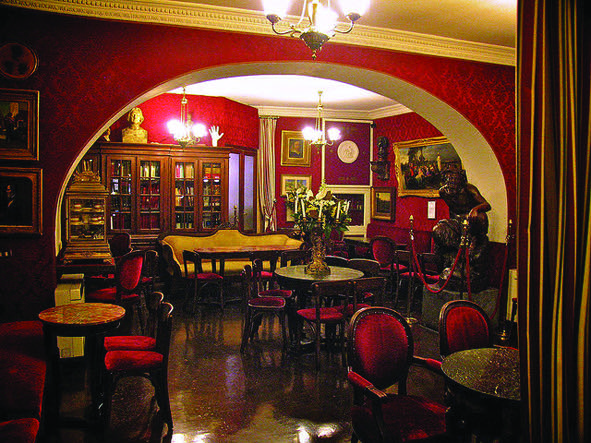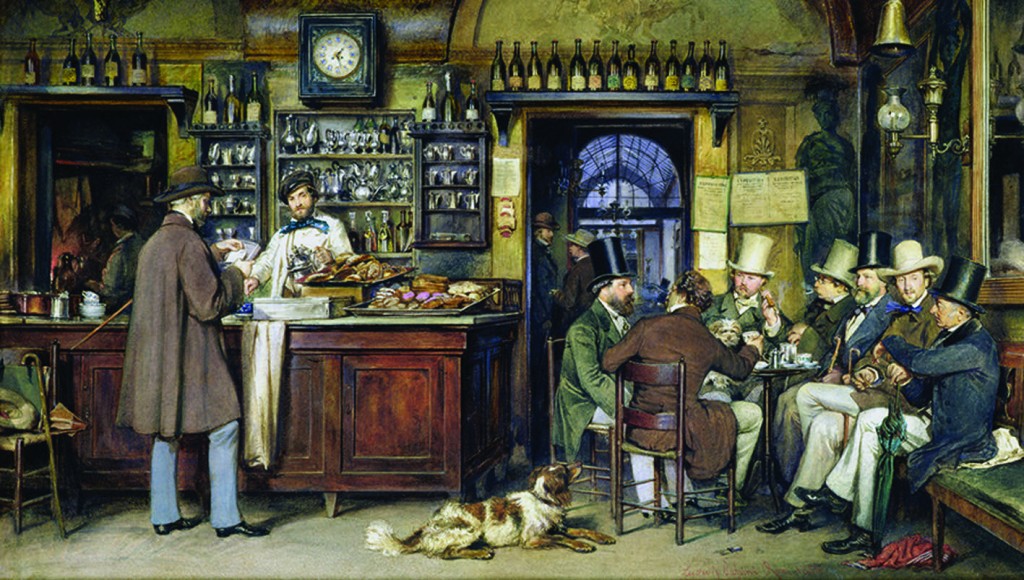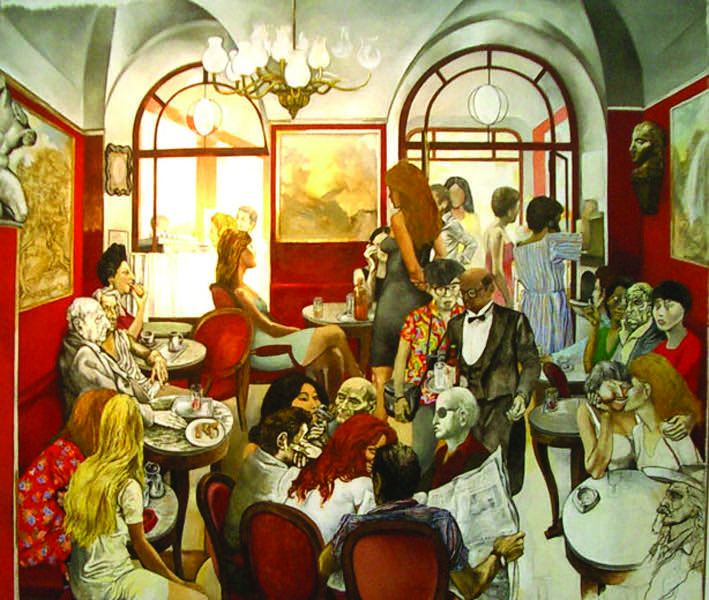
The entrance to the famous restaurant
With a double article about the history of books in this issue’s “Of Books, Art, and People,” what more appropriate time to suggest a visit to Rome’s Caffè Greco! Here for more than 200 years the great minds of art, literature, and music have been meeting around its tiny, marble-topped tables. The café was opened at Via Condotti 86, one of the many spokes of streets running out of the Piazza Spagna, in the 1760s, by a Greek or Levantine, who Italianized his name to Nick da Maddalena. Since then, except for the addition of electricity and other modern conveniences, very little has changed in this literary shrine’s seven, high-ceilinged, red-damask-draped rooms.
It was at first a particular favorite of the Germans, and was affectionately nicknamed Caffè Tedesco (“German Café”). Johann Wolfgang von Goethe (1749-1832) regularly occupied a corner table at which he wrote the last scenes of Iphigenia in Tauris. Johann Heinrich Wilhelm Tischbein (1751-1829), a fellow German and a classical painter who showed Goethe around Rome, was also a regular; one of his landscape drawings of Roman umbrella pines still hangs here.

The back room at the Caffé Greco with Hans Christian Andersen’s yellow sofa
Mark Twain (1835-1910) posed for a sculpture by another customer, Luigi Amici (1817-1897), who left most of his works to the Caffè Greco. The Twain figure, two feet tall, still on display, is a good-natured impression of the cantankerous wit, who called the café his favorite in Rome “because it had nothing by Michelangelo.”
The lugubrious novelist and literary critic Anatole France (1844-1924) visited once or twice, but did not bond with the place. Neither did Felix Mendelssohn (1809-1847): it was shockingly noisy, too full of smoke and rude Germans discussing Titian and Pordenone. Hector Berlioz (1803-1869), in Rome in 1830 on a Prix de Rome scholarship, befriended Mendelssohn here, but shared his dim view, dismissing the place as “the most detestable tavern imaginable… dirty, dark, and damp with nothing to justify the preference which artists of all nations living in Rome accord to it.”
Still, the list of writers and other masters of Western culture, who enjoyed spending their baiocchi — the currency in Italy before unification — and later lire at the café, is a lengthy one. And, malcontents notwithstanding, enthusiasm for the place in its heyday seems reasonable. Wrote Hans Christian Andersen (1805-1875), who lived in the café’s rented rooms overhead in 1861: “We have carpets in all the rooms, views of Rome, and even four mirrors. On the balcony roses and stock bloom. Around dusk, we light a four-armed candelabra in addition to our one large wax candle. In the evening we usually stay home; our round table is set with wine, bread, Parmesan cheese, fruit, and very fresh water from the fountain… A big yellow sofa and three other little ones are part of the furniture.”

Ludwig Passini’s painting of the café
Now the big sofa has moved downstairs to the atmospheric back room where a pianist occasionally plays and invites guests to make themselves comfortable for a coffee or aperitivo.
Over the years, other artists and scholars from Italy, like the poet Giacomo Leopardi (1798-1837), the composer Gioachino Rossini (1792-1868), the bibliophile Vincenzo Pecci (1810-1903), who would later become Pope Leo XIII (1878-1903), and writer Gabriele D’Annunzio (1863-1938), have stopped here for coffee.
Other guests included tenor Enrico Caruso, conductor Arturo Toscanini, painter Renato Guttuso, author Alberto Moravia, the painters Joseph Mallord William Turner and Sir Joshua Reynolds, the novelist Sir Walter Scott, and the poets Lord Byron and Robert Browning with his wife Elizabeth from England. And this is not to mention Benjamin Franklin, Washington Irving, James Fenimore Cooper, Nathaniel Hawthorne, Henry James, Buffalo Bill, and Douglas Fairbanks from the USA, to name just a few.
Prices are higher than most everywhere else at this café designated a national monument in 1953. But, after all, it’s not just the coffee you’re paying for! No wonder that, in his old age, the American painter, illustrator and author Elihu Vedder, a permanent resident of Rome and devotee of the café from 1867 to his death in 1923, purchased one of its marble tables. “I would like to be able to say,” he wrote in his memoirs, “that I can hear the murmur of voices long dead and their stories, but I can’t. The tiny table has never said a word: alas, it knows too many things.” You can’t take a table home, but you can purchase sweets, coffee and even a white and orange Ginori coffee cup with “Caffé Greco” in gold lettering.

Renato Guttuso’s painting of it






Facebook Comments